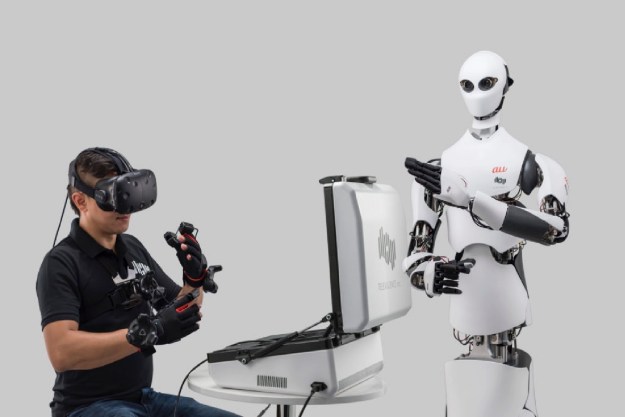Robert “Buz” Chmielewski, a quadriplegic man who suffered an accident in his teens that left him with minimal movement and feeling in his hands, recently fed himself dessert with the aid of two prosthetic robot arms he was able to control using his mind.
Two years ago, Chmielewski underwent a 10-hour brain surgery at Baltimore’s Johns Hopkins Hospital. This was part of a clinical trial designed to allow participants to control assistive devices using neurosignals. As part of the procedure, he had six electrode arrays implanted into both sides of his brain. This has now allowed Chmielewski to be able to control smart prostheses, such as these robot limbs, to carry out tasks like feeding himself.
“Our ultimate goal is to make activities such as eating easy to accomplish, having the robot do one part of the work and leaving the user, in this case Buz, in charge of the details: which food to eat, where to cut, how big the cut piece should be,” David Handelman, a Johns Hopkins University Applied Physics Laboratory (APL) senior roboticist, who specializes in human-machine teaming, said in a statement. “By combining brain-computer interface signals with robotics and artificial intelligence, we allow the human to focus on the parts of the task that matter most.”
How the software works
The software developed by APL uses Chmielewski’s brain signals to first determine where and how to cut using a knife and fork held by the robotic limbs. After this, the software moves the fork to his mouth, with Chmielewski using his brain signals to guide it the last few inches of the way in order that he can eat the food (a Twinkie in this instance.)
This isn’t the first instance we’ve covered of mind-controlled technology for accessibility purposes. Nonetheless, this demonstration shows that the tech — which researchers have been working toward for many years — is now reaching a point where it can be deployed in the real world. In the case of Chmielewski, it was necessary to carry out invasive surgery in order to allow him to control the robot limbs using neurosignals. However, researchers are continuing to investigate ways this could be done less or even noninvasively.
For now, though, it’s enough that this work has allowed a person who wouldn’t otherwise have been able to, to enjoy helping himself to a tasty dessert. “A lot of people take that for granted,” Chmielewski said in a statement. “To be able to do this independently, and still be able to interact with family, is a game-changer.”
Editors' Recommendations
- Robot crushes man to death after mistaking him for a box
- Elon Musk’s Neuralink now recruiting for first human trials
- Space station’s new robotic arm springs to life
- Future armies could use teams of drones and robots to storm buildings
- To build a lifelike robotic hand, we first have to build a better robotic brain


